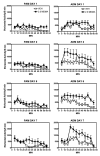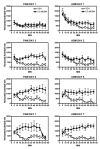Effect of MDMA (ecstasy) on activity and cocaine conditioned place preference in adult and adolescent rats
- PMID: 17049207
- PMCID: PMC1817672
- DOI: 10.1016/j.ntt.2006.09.002
Effect of MDMA (ecstasy) on activity and cocaine conditioned place preference in adult and adolescent rats
Abstract
MDMA (ecstasy) is a drug commonly used in adolescence, and many users of MDMA also use other illicit drugs. It is not known whether MDMA during adolescence alters subsequent responses to cocaine differently than in adults. This study examined the effects of MDMA in adolescent and adult rats on cocaine conditioned reward. At the start of these experiments, adolescent rats were at postnatal day (PND) 33 and adult rats at PND 60. Each rat was treated for 7 days with MDMA (2 or 5 mg/kg/day or vehicle) and locomotor activity was measured. Five days later cocaine conditioned place preference (CPP) was begun. Rats were trained for 3 days, in the morning with saline and in the afternoon with 10 mg/kg cocaine in 30 min sessions, and tested on the fourth day. MDMA stimulated activity in both age groups, but with a greater effect in the adult rats. Sensitization to the locomotor-stimulant effects of the lower dose of MDMA occurred in adult rats and in both groups to the higher dose. Cocaine did not produce a CPP in vehicle-treated adolescent rats, but a significant CPP was observed subsequent to treatment with MDMA. In contrast, cocaine-induced CPP was diminished after MDMA in adult rats. These effects were still evident 2 weeks later upon retest. Thus, under the present conditions, MDMA increased cocaine conditioned reward in adolescent and decreased it in adult rats. These findings suggest that exposure to MDMA during this critical developmental period may carry a greater risk than during adulthood and that male adolescents may be particularly vulnerable to the risk of stimulant abuse after use of MDMA.
Conflict of interest statement
Conflict of Interest
None of the authors have any conflicts of interest related to this manuscript.
Figures






References
-
- Achat-Mendes C, Anderson KL, Itzhak Y. Methylphenidate and MDMA adolescent exposure in mice: long-lasting consequences on cocaine-induced reward and psychomotor stimulation in adulthood. Neuropharmacol. 2003;45:106–15. - PubMed
-
- Adriani W, Laviola G. Elevated levels of impulsivity and reduced place conditioning with d-amphetamine: two behavioral features of adolescence in mice. Behav Neurosci. 2003;117:695–703. - PubMed
-
- Aguirre N, Ballaz S, Lasheras B, Rio JD. MDMA (‘Ecstasy’) enhances 5-HT1A receptor density and 8-OH-DPAT-induced hypothermia: blockade by drugs preventing 5-hydroxytryptamine depletion. Eur J Pharmacol. 1998;346:181–189. - PubMed
-
- Aguirre N, Barrionuevo M, Lasheras B, Rio JD. The role of dopaminergic systems in the perinatal sensitivity to 3,4-methylenedioxymethamphetamine-induced neurotoxicity in rats. J Pharmacol Exp Ther. 1998;286:1159–1165. - PubMed
-
- Belluzzi JD, Lee AG, Oliff HS, Leslie FM. Age-dependent effects of nicotine on locomotor activity and conditioned place preference in rats. Psychopharmacol. 2004;174:389–395. - PubMed
Publication types
MeSH terms
Substances
Grants and funding
LinkOut - more resources
Full Text Sources
Medical

